|
Innovyze Sets Smart Water Geoengineering Standard With ArcGIS 10.1 Compatibility InfoWater, InfoSewer, InfoSWMM, and InfoMaster Run Directly Inside ArcGIS 10.1
|
|||||
|
Broomfield, Colorado USA, July 10, 2012 — Innovyze, a leading global innovator of business analytics software and technologies for wet infrastructure, today announced the full compatibility of its GIS-centric products with ArcGIS 10.1, the latest ArcGIS release from Esri (Redlands, CA). Innovyze is committed to providing the water and wastewater industry with powerful, easy-to-use smart water network modeling and management solutions that are more technologically advanced and perform faster than any others available on the market today. “ArcGIS is the leading enterprise GIS software for water and wastewater utilities around the world,” said Innovyze President and COO Paul F. Boulos, Ph.D., BCEEM, Hon.D.WRE, Dist.D.NE, F.ASCE. “As part of the Innovyze commitment to continually providing novel and incremental improvements and impeccable customer service, we ensure that our products are compatible with ArcGIS solutions on the day they are released. As an Esri Gold Business Partner, we are in constant communication with Esri so that Innovyze software works smoothly and efficiently with their latest releases.” Built atop ArcGIS, InfoWater seamlessly integrates sophisticated analytics, systems dynamics, and optimization functionality directly within the ArcGIS setting. From fire flow and water quality simulations, event backtracking analysis, and energy cost and carbon footprint analysis to pressure zone management and advanced genetic algorithm and particle swarm optimization, the InfoWater product suite comes equipped with everything water utility owner-operators need to best plan, design, operate, secure, and sustain their distribution systems. The software also serves as a base platform for advanced modeling, operational, asset management, and capital planning extensions. Among these critical applications are IWLive (real-time operations and security), InfoWater UDF (unidirectional flushing). CapPlan Water (risk-based capital planning), InfoWater MSX (multispecies, temperature, and particle transport and deposition modeling). InfoSurge (transient analysis and design), andInfoWater VCM (valve criticality assessment). InfoSewer is used worldwide by municipal engineers and planners to create detailed, accurate models of their sewer infrastructure systems. With these models users can evaluate the effect of new developments, zoning changes, and other additional loads on system flows; pinpoint current and future problem areas; predict overflows and backups; and determine how to best restore (and with the least rehabilitation) needed capacity lost to infiltration and inflow. In addition, users rely on these models to compute hydrogen sulfide generation and corrosion potential; analyze the rate of biochemical oxygen demand (BOD) exertion; track sediment movement and deposition; trace pollutant contribution from source nodes; perform time-of-concentration pipe calculations; calculate the amount of pollutant transported to the wastewater treatment plant; and assess pollutants’ impacts on receiving waters. Extensive scenario management and automated design tools give users the ability to analyze existing or future sewage collection systems. The only urban drainage modeling solution certified by the National Association of GIS-centric Software, the full-featured InfoSWMM analysis and design program delivers the highest rate of return in the industry. All operations of a typical sewer system — from analysis and design to management functions such as water quality assessment, pollution prediction, sediment transport and deposition, urban flooding, real-time control, and record keeping — are addressed in a single, fully integrated geoengineering environment. The program’s powerful hydraulic and water quality computational engine is based on the current SWMM 5 version, which is endorsed by the USEPA and certified by FEMA. These features and more result in an enhanced modeling experience and greater realism of displayed results — advantages that translate to increased productivity, reduced costs, higher accuracy, better efficiency, and improved designs. InfoSWMM also serves as a robust base platform for advanced modeling, operational, and capital planning. Some of these critical applications include InfoSWMM 2D(two-dimensional surface flood modeling), CapPlan Sewer (risk-based capital planning and asset performance modeling), and RDII Analyst (rainfall-dependent inflow and infiltration planning and analysis). InfoMaster revolutionizes the business analytics and optimization (BAO) industry for water and wastewater utilities with its “out-of-the-box” approach to geospatial wet infrastructure asset management, a distinct point of differentiation from traditional enterprise resource planning (ERP) solutions. Where the typical enterprise software deployment requires a 12- to 18-month implementation cycle, InfoMaster can be deployed in just a day to a few weeks. Where other ERP systems are focused on electronic records management, InfoMaster is built from the ground up to provide superior business analytics and modeling capabilities. Thanks to the software’s unique capabilities, utilities for the first time can now manage and control both the flow of data and the flow of water for better, faster, and more accurate decision making. And because InfoMaster allows data to be organized by project, a single BAO package can now be utilized by both the utility and its engineering consultants with enormous flexibility to manage data for multiple utilities. Pricing and Availability |
Sewer Toshers from Smithsonian Blog: the men who made it their living by forcing entry into London’s sewers at low tide and wandering through them, sometimes for miles, searching out and collecting the miscellaneous scraps washed down from the streets above: bones, fragments of rope, miscellaneous bits of metal, silver cutlery and–if they were lucky–coins dropped in the streets above and swept into the gutters.
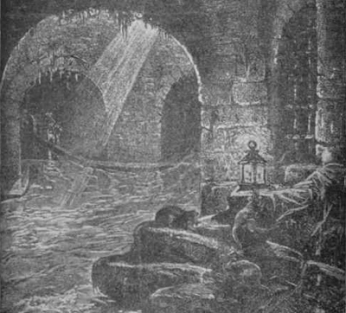
A London sewer in the19th century. This one, as evidenced by the shaft of light penetrating through a grating, must be close to the surface; others ran as deep as 40 feet beneath the city.
Mayhew called them “sewer hunters” or “toshers,” and the latter term has come to define the breed, though it actually had a rather wider application in Victorian times–the toshers sometimes worked the shoreline of the Thames rather than the sewers, and also waited at rubbish dumps when the contents of damaged houses were being burned and then sifted through the ashes for any items of value. They were mostly celebrated, nonetheless, for the living that the sewers gave them, which was enough to support a tribe of around 200 men–each of them known only by his nickname: Lanky Bill, Long Tom, One-eyed George, Short-armed Jack. The toshers earned a decent living; according to Mayhew’s informants, an average of six shillings a day–an amount equivalent to about $50 today. It was sufficient to rank them among the aristocracy of the working class–and, as the astonished writer noted, “at this rate, the property recovered from the sewers of London would have amounted to no less than £20,000 [today $3.3 million] per annum.”
The toshers’ work was dangerous, however, and–after 1840, when it was made illegal to enter the sewer network without express permission, and a £5 reward was offered to anyone who informed on them–it was also secretive, done mostly at night by lantern light. “They won’t let us in to work the shores,” one sewer-hunter complained, “as there’s a little danger. They fears as how we’ll get suffocated, but they don’t care if we get starved!”
Quite how the members of the profession kept their work a secret is something of a puzzle, for Mayhew makes it clear that their dress was highly distinctive. “These toshers,” he wrote,
may be seen, especially on the Surrey side of the Thames, habited in long greasy velveteen coats, furnished with pockets of vast capacity, and their nether limbs encased in dirty canvas trousers, and any old slops of shoes… [They] provide themselves, in addition, with a canvas apron, which they tie round them, and a dark lantern similar to a policeman’s; this they strap before them on the right breast, in such a manner that on removing the shade, the bull’s eye throws the light straight forward when they are in an erect position… but when they stoop, it throws the light directly under them so that they can distinctly see any object at their feet. They carry a bag on their back, and in their left hand a pole about seven or eight feet long, one one end of which there is a large iron hoe.
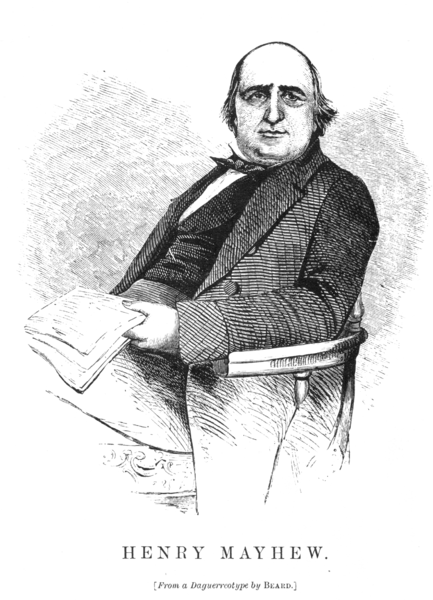
Henry Mayhew chronicled London street life in the 1840s and ’50s, producing an incomparable account of desperate living in the working classes’ own words.
This hoe was the vital tool of the sewer hunters’ trade. On the river, it sometimes saved their lives, for “should they, as often happens, even to the most experienced, sink in some quagmire, they immediately throw out the long pole armed with the hoe, and with it seizing hold of any object within reach, are thereby enabled to draw themselves out.” In the sewers, the hoe was invaluable for digging into the accumulated muck in search of the buried scraps that could be cleaned and sold.
Knowing where to find the most valuable pieces of detritus was vital, and most toshers worked in gangs of three or four, led by a veteran who was frequently somewhere between 60 and 80 years old. These men knew the secret locations of the cracks that lay submerged beneath the surface of the sewer-waters, and it was there that cash frequently lodged. “Sometimes,” Mayhew wrote, “they dive their arm down to the elbow in the mud and filth and bring up shillings, sixpences, half-crowns, and occasionally half-sovereigns and sovereigns. They always find these the coins standing edge uppermost between the bricks in the bottom, where the mortar has been worn away.”
Life beneath London’s streets might have been surprisingly lucrative for the experienced sewer-hunter, but the city authorities had a point: It was also tough, and survival required detailed knowledge of its many hazards. There were, for example, sluices that were raised at low tide, releasing a tidal wave of effluent-filled water into the lower sewers, enough to drown or dash to pieces the unwary. Conversely, toshers who wandered too far into the endless maze of passages risked being trapped by a rising tide, which poured in through outlets along the shoreline and filled the main sewers to the roof twice daily.
Yet the work was not was unhealthy, or so the sewer-hunters themselves believed. The men that Mayhew met were strong, robust and even florid in complexion, often surprisingly long-lived–thanks, perhaps, to immune systems that grew used to working flat out–and adamantly convinced that the stench that they encountered in the tunnels “contributes in a variety of ways to their general health.” They were more likely, the writer thought, to catch some disease in the slums they lived in, the largest and most overcrowded of which was off Rosemary Lane, on the poorer south side of the river.
Access is gained to this court through a dark narrow entrance, scarcely wider than a doorway, running beneath the first floor of one of the houses in the adjoining street. The court itself is about 50 yards long, and not more than three yards wide, surrounded by lofty wooden houses, with jutting abutments in many upper storeys that almost exclude the light, and give them the appearance of being about to tumble down upon the heads of the intruder. The court is densely inhabited…. My informant, when the noise had ceased, explained the matter as follows: “You see, sir, there’s more than thirty houses in this here court, and there’s no less than eight rooms in every house; now there’s nine or ten people in some of the rooms, I knows, but just say four in every room and calculate what that there comes to.” I did, and found it, to my surprise, to be 960. “Well,” continued my informant, chuckling and rubbing his hands in evident delight at the result, “you may as well just tack a couple of hundred on to the tail o’ them for makeweight, as we’re not werry pertikler about a hundred or two one way or the other in these here places.”
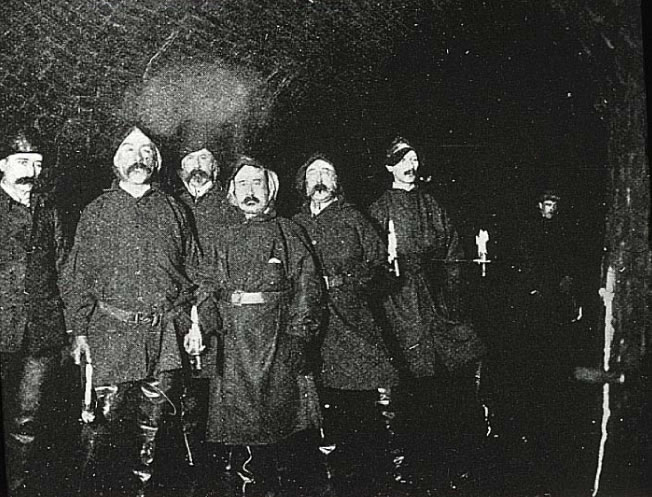
A gang of sewer-flushers–employed by the city, unlike the toshers–in a London sewer late in the 19th century.
No trace has yet been found of the sewer-hunters prior to Mayhew’s encounter with them, but there is no reason to suppose that the profession was not an ancient one. London had possessed a sewage system since Roman times, and some chaotic medieval construction work was regulated by Henry VIII’sBill of Sewers, issued in 1531. The Bill established eight different groups of commissioners and charged them with keeping the tunnels in their district in good repair, though since each remained responsible for only one part of the city, the arrangement guaranteed that the proliferating sewer network would be built to no uniform standard and recorded on no single map.
Thus it was never possible to state with any certainty exactly how extensive the labrynth under London was. Contemporary estimates ran as high as 13,000 miles; most of these tunnels, of course, were far too small for the toshers to entert, but there were at least 360 major sewers, bricked in the 17th century. Mayhew noted that these tunnels averaged a height of 3 feet 9 inches, and since 540 miles of the network was formally surveyed in the 1870s it does not seem too much to suggest that perhaps a thousand miles of tunnel was actually navigable to a determined man. The network was certainly sufficient to ensure that hundreds of miles of uncharted tunnel remained unknown to even the most experienced among the toshers.
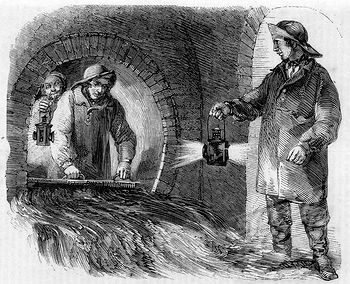
Sewer-flushers work one of the subterranean sluices that occasionally proved fatal to unwary toshers caught downstream of the unexpected flood.
It is hardly surprising, in these circumstances, that legends proliferated among the men who made a living in the tunnels. Mayhew recorded one of the most remarkable bits of folklore common among the toshers: that a “race of wild hogs” inhabited the sewers under Hampstead, in the far north of the city. This story–a precursor of the tales of “alligators in the sewers” heard in New York a century later–suggested that a pregnant sow
by some accident got down the sewer through an opening, and, wandering away from the spot, littered and reared her offspring in the drain; feeding on the offal and garbage washed into it continually. Here, it is alleged, the breed multiplied exceedingly, and have become almost as ferocious as they are numerous.
Thankfully, the same legend explained, the black swine that proliferated under Hampstead were incapable of traversing the tunnels to emerge by the Thames; the construction of the sewer network obliged them to cross Fleet Ditch–a bricked-over river–“and as it is the obstinate nature of a pig to swim against the stream, the wild hogs of the sewers invariably work their way back to their original quarters, and are thus never to be seen.”
A second myth, far more eagerly believed, told of the existence (Jacqueline Simpson and Jennifer Westwood record) “of a mysterious, luck-bringing Queen Rat”:
This was a supernatural creature whose true appearance was that of a rat; she would follow the toshers about, invisibly, as they worked, and when she saw one that she fancied she would turn into a sexy-looking woman and accost him. If he gave her a night to remember, she would give him luck in his work; he would be sure to find plenty of money and valuables. He would not necessarily guess who she was, for though the Queen Rat did have certain peculiarities in her human form (her eyes reflected light like an animal’s, and she had claws on her toes), he probably would not notice them while making love in some dark corner. But if he did suspect, and talked about her, his luck would change at once; he might well drown, or meet with some horrible accident.
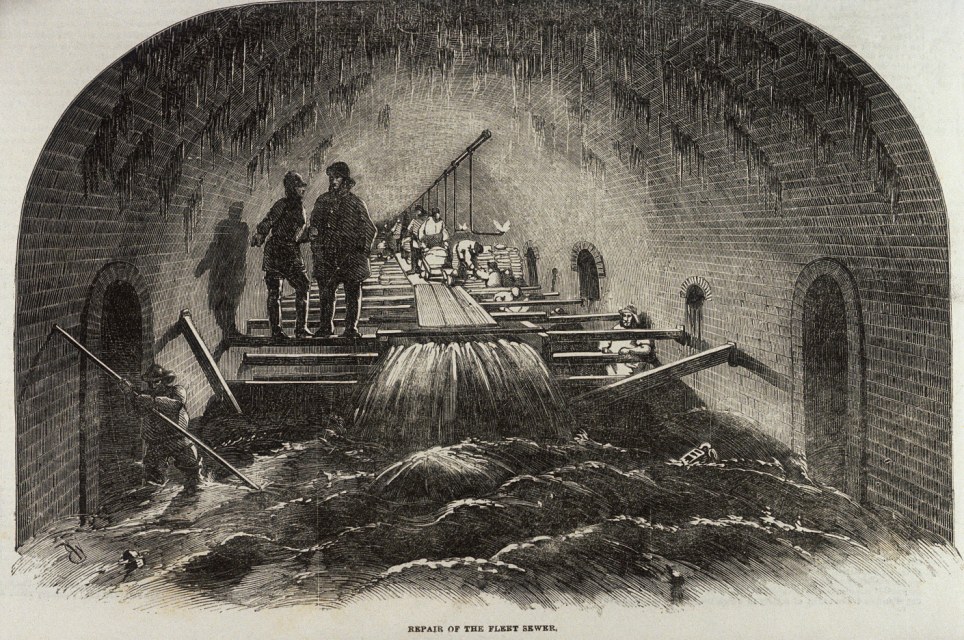
Repairing the Fleet Sewer. This was one of the main channels beneath London, and carried the waters of what had once been a substantial river–until the expansion of the city caused it to be built over and submerged.
One such tradition was handed down in the family of a tosher named Jerry Sweetly, who died in 1890, and finally published more than a century later. According to this family legend, Sweetly had encountered the Queen Rat in a pub. They drank until midnight, went to a dance, “and then the girl led him to a rag warehouse to make love.” Bitten deeply on the neck (the Queen Rat often did this to her lovers, marking them so no other rat would harm them), Sweetly lashed out, causing the girl to vanish and reappear as a gigantic rat up in the rafters. From this vantage point, she told the boy: “You’ll get your luck, tosher, but you haven’t done paying me for it yet!”
Offending the Queen Rat had serious consequences for Sweetly, the same tradition ran. His first wife died in childbirth, his second on the river, crushed between a barge and the wharf. But, as promised by legend, the tosher’s children were all lucky, and once in every generation in the Sweetly family a female child was born with mismatched eyes–one blue, the other grey, the color of the river.
Queen Rats and mythical sewer-pigs were not the only dangers confronting the toshers, of course. Many of the tunnels they worked in were crumbling and dilapidated–“the bricks of the Mayfairsewer,” Peter Ackroyd says, “were said to be as rotten as gingerbread; you could have scooped them out with a spoon”–and they sometimes collapsed, entombing the unwary sewer hunters who disturbed them. Pockets of suffocating and explosive gases such as “sulphurated hydrogen” were also common, and no tosher could avoid frequent contact with all manner of human waste. The endlessly inquisitive Mayhew recorded that the “deposit” found in the sewers
has been found to comprise all the ingredients from the gas works, and several chemical and mineral manufactories; dead dogs, cats, kittens, and rats; offal from the slaughter houses, sometimes even including the entrails of the animals; street pavement dirt of every variety; vegetable refuse, stable-dung; the refuse of pig-styes; night-soil; ashes; rotten mortar and rubbish of different kinds.

Joseph Bazalgette’s new sewage system cleared the Thames of filth and saved the city from stench and worse, as well as providing London with a new landmark: The Embankment, which still runs along the Thames, was built to cover new super-sewers that carried the city’s effluent safely east toward the sea.
That the sewers of mid-19th-century London were foul is beyond question; it was widely agreed, Michelle Allen says, that the tunnels were “volcanoes of filth; gorged veins of putridity; ready to explode at any moment in a whirlwind of foul gas, and poison all those whom they failed to smother.” Yet this, the toshers themselves insisted, did not mean that working conditions under London were entirely intolerable. The sewers, in fact, had worked fairly efficiently for many years–not least because, until 1815, they were required to do little more than carry off the rains that fell in the streets. Before that date, the city’s latrines discharged into cesspits, not the sewer network, and even when the laws were changed, it took some years for the excrement to build up.
By the late 1840s, though, London’s sewers were deteriorating sharply, and the Thames itself, which received their untreated discharges, was effectively dead. By then it was the dumping-ground for 150 million tons of waste each year, and in hot weather the stench became intolerable; the city owes its present sewage network to the “Great Stink of London,” the infamous product of a lengthy summer spell of hot, still weather in 1858 that produced a miasma so oppressive that Parliament had to be evacuated. The need for a solution became so obvious that the engineer Joseph Bazalgette–soon to be Sir Joseph, a grateful nation’s thanks for his ingenious solution to the problem–was employed to modernize the sewers. Bazalgette’s idea was to build a whole new system of super-sewers that ran along the edge of the river, intercepted the existing network before it could discharge its contents, and carried them out past the eastern edge of the city to be processed in new treatment plants.
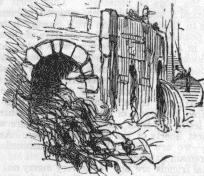
The exit of a London sewer before Bazalgette’s improvements, from Punch (1849). These outflows were the points through which the toshers entered the underground labrynth they came to know so well.
Even after the tunnels deteriorated and they became increasingly dangerous, though, what a tosher feared more than anything else was not death by suffocation or explosion, but attacks by rats. The bite of a sewer rat was a serious business, as another of Mayhew’s informants, Jack Black–the “Rat and Mole Destroyer to Her Majesty”–explained.”When the bite is a bad one,” Black said, “it festers and forms a hard core in the ulcer, which throbs very much indeed. This core is as big as a boiled fish’s eye, and as hard as stone. I generally cuts the bite out clean with a lancet and squeezes…. I’ve been bitten nearly everywhere, even where I can’t name to you, sir.”
There were many stories, Henry Mayhew concluded, of toshers’ encounters with such rats, and of them “slaying thousands… in their struggle for life,” but most ended badly. Unless he was in company, so that the rats dared not attack, the sewer-hunter was doomed. He would fight on, using his hoe, “till at last the swarms of the savage things overpowered him.” Then he would go down fighting, his body torn to pieces and the tattered remains submerged in untreated sewage, until, a few days later, it became just another example of the detritus of the tunnels, drifting toward the Thames and its inevitable discovery by another gang of toshers–who would find the remains of their late colleague “picked to the very bones.”
Subject: How Does Green Ampt Initial Moisture Defiict in SWMM 5?
This graph shows the values of the internal SWMM 5 parameters for Green Ampt Infiltration for the pervious area of a Subcatchment during a simulation. The parameters are:
· Soil Moisture = IMD Max – (FUMax – FU)/Upper Soil Zone Depth
· FU or current moisture content of the upper zone of the of the soil
· FUMax which is the saturated moisture content of the upper zone in feet and stays constant during the simulation
· IMD Max is the user defined Initial soil moisture deficit and is a fraction

Figure 1. How Soil Moisture changes over time.

Figure 2. Soil Moisture and IMD are related – the Soil Moisture has a maximum of IMDMax.
Subject: How Does Green Ampt Cumulative Event Infiltration work in SWMM 5?
This graph shows the values of the internal SWMM 5 parameters for Green Ampt Infiltration for the pervious area of a Subcatchment during a simulation. The parameters are:
· F or FTOT which is the cumulative event infiltration at the start of a time interval in the internal units of feet in SWMM 5,
· FU or current moisture content of the upper zone of the of the soil
· FUMAX which is the saturated moisture content of the upper zone in feet and stays constant during the simulation

Figure 1. How FTOT, FU and F change over time

Figure 2. A closer look at how FTOT or F and FU Change over time in a Green Ampt Pervious Area Simulation.
Subject: How are Negative Transect Elevations Used in SWMM5?
You can have negative elevations in the Transects of SWMM 5 as the elevations are transformed internally to relative depths above the node inverts in the SWMM 5 engine (Figure 1). The slope of the link is calculated from the link offset elevations (Figure 3) and the cross sectional information for the irregular link in SWMM 5 (Figure 2) is computed from the Transect data (Figure 4). The Water Surface elevation of the link is based on the node inverts (Figure 5).
|
|
|
Figure 1. Transect Editor of SWMM 5 |
|
|
|
Figure 2. The Transect Data is Used in the Irregular of HEC-RAS Shape of SWMM 5 |
|
|
|
Figure 3. The slope of the link with the Transect is calculated from the link upstream and downstream offset elevations – not the Transect data which is relative. |
|
|
|
Figure 4. Transect Data Transformed into Tables of Area, Hydraulic Radius and Width from the Transect Data internally in SWMM 5. |
|
|
|
Figure 5. HGL of the Water Surface Elevation from the Node Invert and Link Offset Elevations. |




